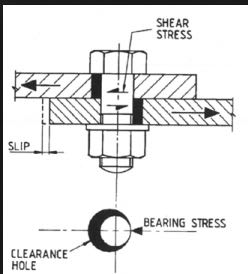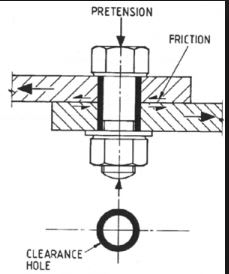Navigation
Install the app
How to install the app on iOS
Follow along with the video below to see how to install our site as a web app on your home screen.
Note: This feature may not be available in some browsers.
More options
Style variation
-
Congratulations cowski on being selected by the Eng-Tips community for having the most helpful posts in the forums last week. Way to Go!
You are using an out of date browser. It may not display this or other websites correctly.
You should upgrade or use an alternative browser.
You should upgrade or use an alternative browser.
Slip critical connection 2
- Thread starter Veer007
- Start date
- Status
- Not open for further replies.
trustthemodel
Structural
The AISC Steel Construction Manual would be a good starting reference.
Before doing that I would recommend you double check the application and figure out whether the slip critical bolts are really the way to go.
Before doing that I would recommend you double check the application and figure out whether the slip critical bolts are really the way to go.
DrZoidberWoop
Structural
No. A325SC can be the same bolt as an A325N, but designed for a "slip critical" condition, which reduces the bolt's load capacity. The condition of the surfaces you want to bring into contact is a factor in this. The RCSC seems to be the go-to document for high-strength bolts
-
2
- #4
Don't confuse bolt type with connection type.
There are essentially two types of connections, bearing connections and slip critical connections.
A bearing connection carries load by contact between the side of the bolt bearing against the bolt hole, putting the bolt in shear, see below:

The bolt used in a bearing connection can be designated to include the threads of the bolt in the shear plane (designated with "N") or to exclude the threads from the shear plane (designated with "X")
A slip critical connection has the bolts installed to a specified pretension which clamps the two surfaces together so that the load is transferred through friction between the two surfaces, not through direct bearing, see below:

A slip critical connection requires that the two surfaces be prepared in a certain manner to ensure the expected friction develops between them.
Now on to bolts, there are essentially two strength types used.
Bolts with a strength of 120 ksi which include A325 and F1852 for twist off type
and bolts with a strength of 150 ksi which include A490 and F2280 (again twist off)
As noted above, these bolts can be designated as N, X, or SC (or blank). If the bolt is designated as A325N, this is a bearing type connection in which the threads of the bolts may be included in the shear plane. If it is designated as A325X, this is a bearing type connection in which the threads must be excluded from the shear plane. Finally, if it is designated as A325SC, it is a slip critical connection in which the surfaces must be prepared properly and the bolt must be installed to a specific pretension.
If there is no letter designation the spec may specify what the connection needs to be, otherwise it is generally understood that no designation means "N".
There are essentially two types of connections, bearing connections and slip critical connections.
A bearing connection carries load by contact between the side of the bolt bearing against the bolt hole, putting the bolt in shear, see below:

The bolt used in a bearing connection can be designated to include the threads of the bolt in the shear plane (designated with "N") or to exclude the threads from the shear plane (designated with "X")
A slip critical connection has the bolts installed to a specified pretension which clamps the two surfaces together so that the load is transferred through friction between the two surfaces, not through direct bearing, see below:

A slip critical connection requires that the two surfaces be prepared in a certain manner to ensure the expected friction develops between them.
Now on to bolts, there are essentially two strength types used.
Bolts with a strength of 120 ksi which include A325 and F1852 for twist off type
and bolts with a strength of 150 ksi which include A490 and F2280 (again twist off)
As noted above, these bolts can be designated as N, X, or SC (or blank). If the bolt is designated as A325N, this is a bearing type connection in which the threads of the bolts may be included in the shear plane. If it is designated as A325X, this is a bearing type connection in which the threads must be excluded from the shear plane. Finally, if it is designated as A325SC, it is a slip critical connection in which the surfaces must be prepared properly and the bolt must be installed to a specific pretension.
If there is no letter designation the spec may specify what the connection needs to be, otherwise it is generally understood that no designation means "N".
A few things that need to be mentioned. First, slip critical bolts still need to be checked for bearing even though the connection may not be designed to go into bearing.
Second, SC, N, and X are used to define the type of connection and do not indicate the mechanical properties of the bolt. A A325N bolt has the same mechanical properties as a A325SC bolt.
However, as others have alluded to above, the DESIGN STRENGTH is different for A325N and A325SC bolts.
Second, SC, N, and X are used to define the type of connection and do not indicate the mechanical properties of the bolt. A A325N bolt has the same mechanical properties as a A325SC bolt.
However, as others have alluded to above, the DESIGN STRENGTH is different for A325N and A325SC bolts.
- Thread starter
- #6
- Thread starter
- #7
- Thread starter
- #8
- Thread starter
- #11
- Status
- Not open for further replies.
Similar threads
- Replies
- 7
- Views
- 2K
- Question
- Replies
- 1
- Views
- 425
- Replies
- 7
- Views
- 12K
- Replies
- 4
- Views
- 8K
- Replies
- 5
- Views
- 3K
